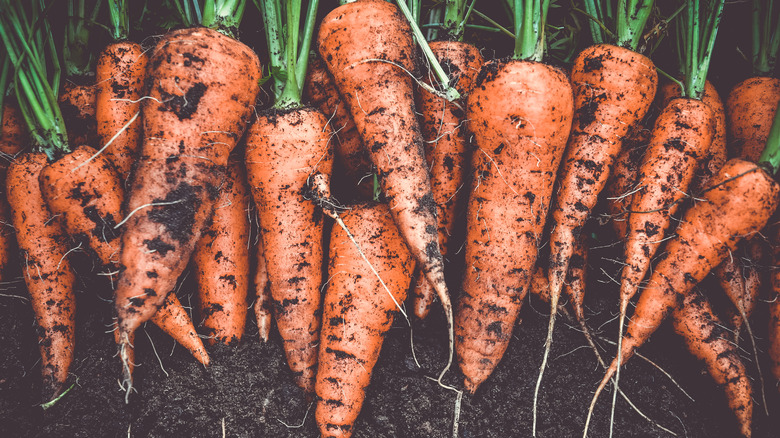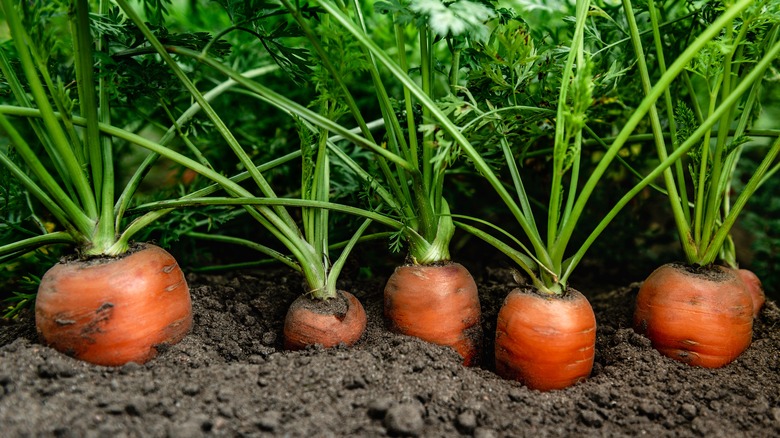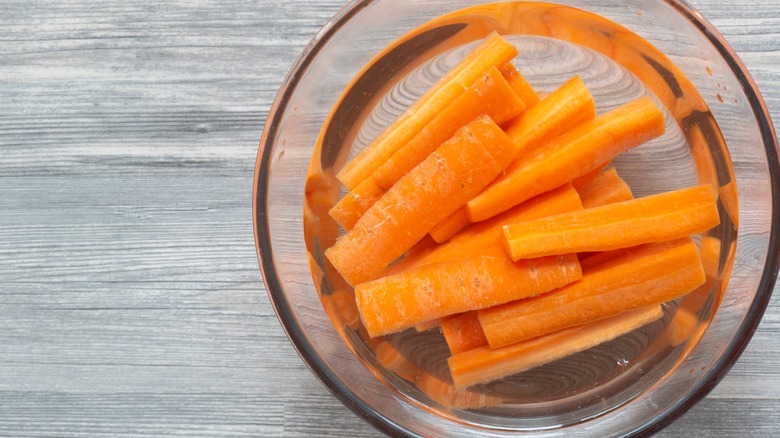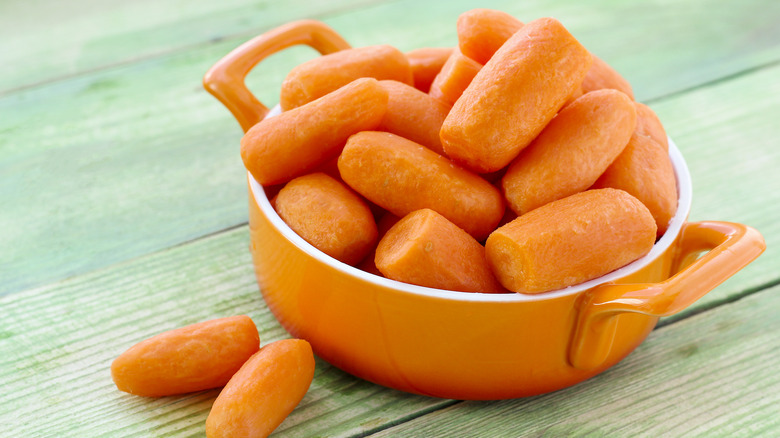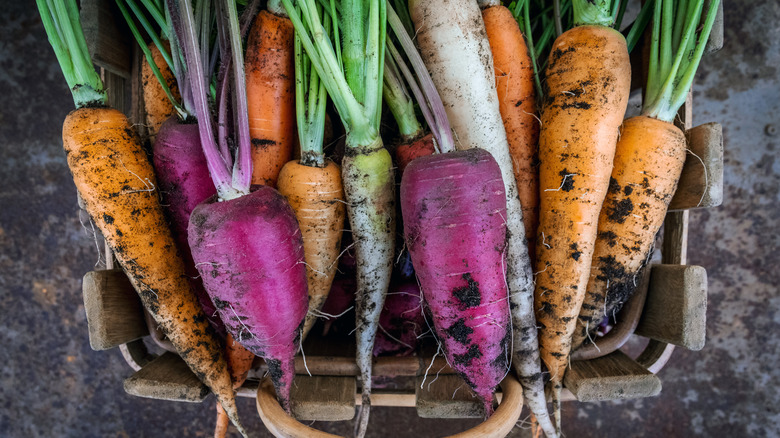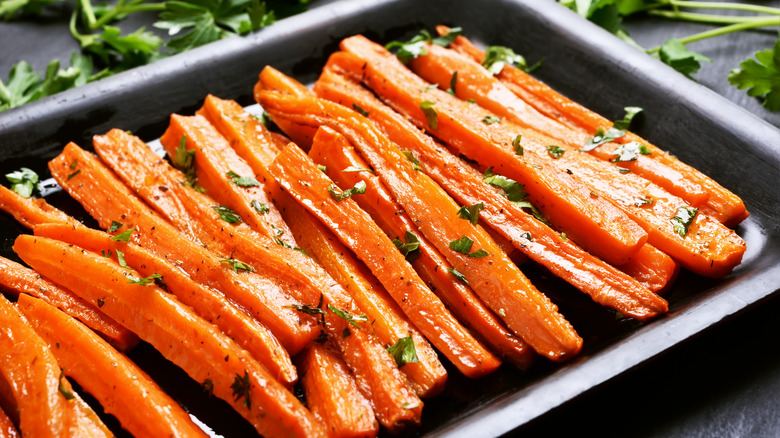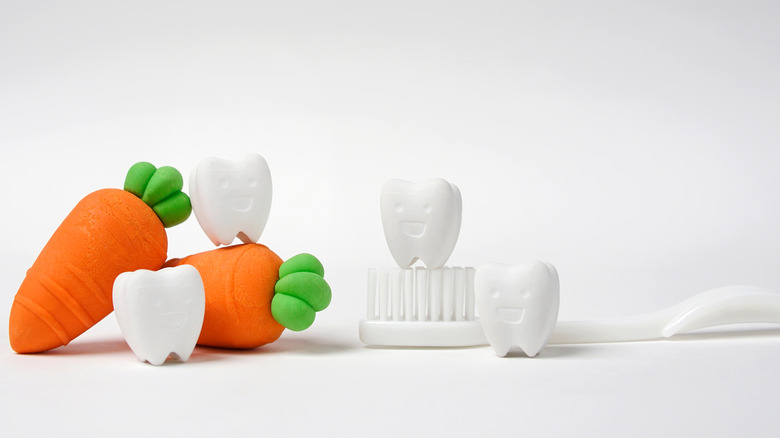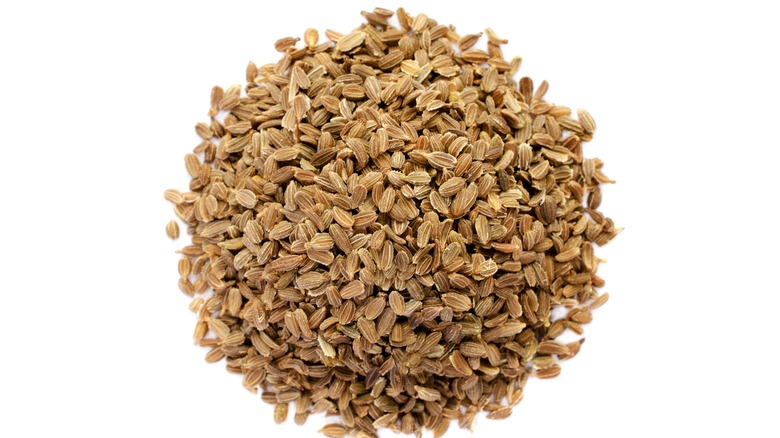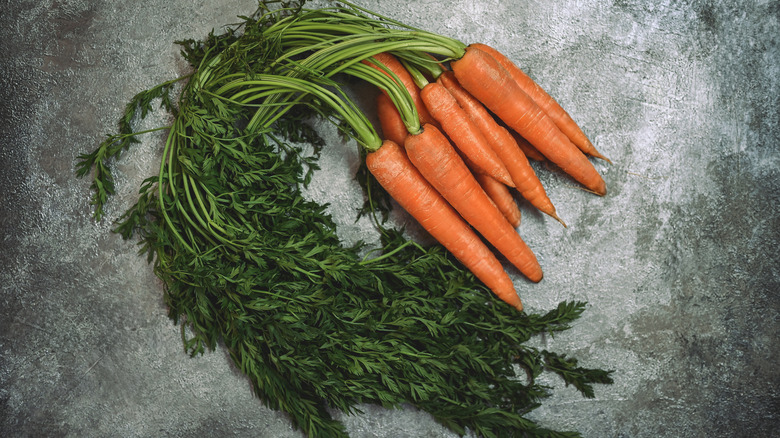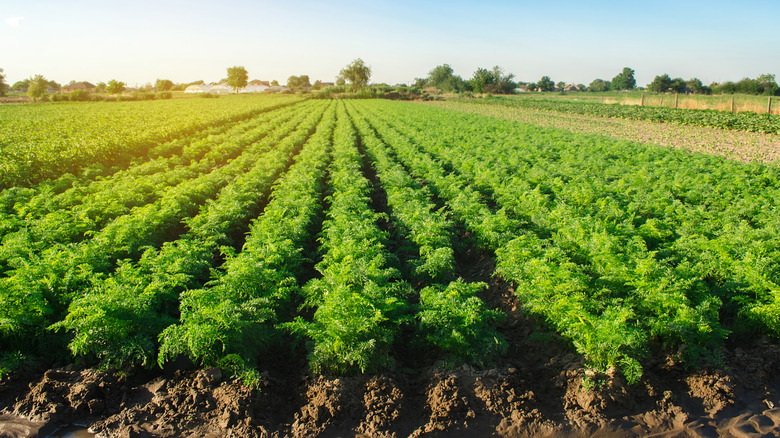Carrot Trivia: 12 Fun Facts About The Root Vegetable
Everyone knows carrots are good for your eyes, but there are a lot of surprising things about them you probably haven't considered. You may think you already know everything about the beloved, healthy vegetable, but spoiler alert: Unless you're a carrot trivia expert, chances are good you don't know it all. We're not just talking about their scientific name, Daucus carota, either. From their ability to thrive underground during the winter to what parts are edible to their many uses and benefits, there's a lot to learn about carrots.
To uncover lesser-known facts about carrots, I combed through gardening expert recommendations and insights, medicinal research, particulars from the USDA, carrot history and production data, and more to bring you the most fascinating information. Keep reading to learn 12 fun facts about the root vegetable, so the next time you munch on some carrots, you can not only use them to their full potential but wow your friends with fun trivia as well.
Carrots don't have to be harvested before winter
Harvesting vegetables before winter is pretty much gardening 101, but shockingly, this isn't necessary with carrots. Sure, you can obviously pull them up before winter sets in, but they are actually equipped to survive the winter months while underground. With a few easy steps, you can set your carrots up to withstand cold (even harsh) conditions that would cause other vegetables to wither and die.
According to Gardening Know How, overwintering carrots starts with weeding the space around your carrots to ensure you don't inadvertently contribute to their growth as well. Then, you want to cover the bed with a dense layer of leaves or straw, making sure it comes right up to the base of your carrot's stalks, and you're all set. You can venture out to your garden all winter and pull up carrots as needed. The experts at Gardening Know How also note that you'll need to extract all of your carrots before early Spring when they flower and become inedible.
As the winter season progresses, don't be alarmed when the carrot tops die; this is normal. As such, you may want to insert markers where your carrots are planted to help you identify their placement for easy harvesting. In addition, your carrots will likely get sweeter the more time they spend underground when it is cold. Apparently, this is a natural response because carrots concentrate their sugar levels as a survival tactic.
Carrots are 88% water
Carrots are often thought of as a healthy snack because they are high in vitamins and nutrients. This is nothing new, but what you might not know is that they have a super high water content, about 88%, according to the USDA. That's a lot of water for one little vegetable.
Carrots offer you a hearty snack or ingredient for a meal, but due to their extremely high water content, most of what fills you up is water. Of course, you get all the other nutritional benefits, but their high level of moisture is one of the primary reasons they are considered a fantastic snack for people on a diet or anyone looking to monitor their food intake. Basically, you can eat a ton of carrots without indulging in empty calories. Instead, you get a burst of nutrition and full feeling caused by water, not carbs or fat.
Baby carrots are just pre-cut carrots
While there are many different varieties of carrots, baby carrots are not one of them. Considering their widespread popularity and smart labeling, it is easy to confuse them with a specific type of carrot. However, they are just regular carrots that have been pre-shaped, cut, and peeled to look, well, appealing. There are probably lots of things you might not know about baby carrots, but the fact that they are ordinary carrots is one of the most unexpected. You've likely seen them labeled petite carrots, which is even more misleading because petite carrot varieties actually exist, but you won't be fooled anymore.
Baby carrots are the brainchild of California farmers Mike Yurosek and his son Dave. They were bothered by the fact that they had to toss out an abundance of their crop due to cosmetic imperfections and also wanted to minimize prep time in the kitchen. When their two concerns collided, they came up with the idea to trim, buff, and market their misshapen carrots as appetizing baby carrots, and boy, did it work. In fact, CBS News reports that 70% of the carrots purchased today are baby carrots.
Carrots aren't always orange; they can be different colors
The most common carrots are orange, but they also come in white, yellow, and purple colors. More recently, rainbow-colored carrots have been growing in popularity, but for a long time now, orange carrots have been the standard. Interestingly though, initially carrots were not orange. The first carrots, which are thought to have originated in Asia around 900 C.E., were yellow and purple (via Mississippi State University Extension). Orange carrots didn't become prevalent until Dutch horticulturists started cultivating and breeding them in the 1600s.
Fast forward to today, and rainbow carrots are starting to regain some traction. They'll probably never surpass orange carrots again, but they are definitely grabbing the attention of chefs and home cooks everywhere. As a result, you can easily find them in almost any grocery store. Some grocers may only stock full-size rainbow carrots, and others may only sell rainbow baby carrots, but you're likely to find at least one of the two at any major store. Farmers' markets are also a fantastic place to buy rainbow carrots.
If you decide to give different colored carrots a try, you can cook with them like normal. Of course, you can also enjoy them raw as a snack, in a rainbow carrot salad, or any other recipe you dream up. The taste varies slightly from one color to the next, but for the most part, the flavor is pretty similar once cooked.
Cooked carrots are more nutritious than raw carrots
Considering how we've been told all our lives that raw vegetables are better for you than cooked ones, it may be hard to believe, but the opposite is true for carrots. A study published in 2000 by the Journal of Agricultural and Food Chemistry shows that cooking carrots leads to an increase in beta-carotene. The beta-carotene in carrots is what gives them their orange color, but it is also highly beneficial regarding nutritional value. That's because beta-carotene is converted into vitamin A by the body and then used to promote several bodily functions. According to Healthline, vitamin A assists in immune system functionality, bone health and formation, healthy reproduction, cancer prevention, a reduced risk for acne, and the preservation of vision as you age.
A different study published in 2007 by the Journal of Agricultural and Food Chemistry showed that steaming and boiling carrots and other vegetables like broccoli and courgettes resulted in positive nutritional values, especially when compared to frying. Particularly, boiling carrots led to better preservation of antioxidant compounds like carotenoids and ascorbic acid. More commonly known as vitamin C, ascorbic acid plays an essential role in tissue growth and repair throughout your body. It is used to help heal wounds, make collagen, promote bone and teeth health, and more (via Mount Sinai).
Carrots are like natural toothbrushes
Carrots, especially raw or thick chunks of carrot, are rather abrasive. As a result, they assist in breaking up tartar and plaque buildup on your teeth while chewing them. Once cooked, carrots soften considerably, but when they are still crunchy, they work wonders for your teeth. Snodgrass-King, a multi-specialty dental practice, goes so far as to say that carrots function like natural toothbrushes. Their ability to clean off food and bacteria helps prevent potential cavities and other harmful buildup. Eating a lot of carrots doesn't mean you don't need to brush your teeth, but most of us will take all the help we can get in that department.
Snodgrass-King also emphasizes that carrots are packed full of vitamins and nutrients that work to promote oral health in other ways. They are rich in calcium, phosphorus, potassium, and Vitamin A, all of which are good for your teeth. From improved enamel to stronger teeth, carrots have you covered. Their high biotin, fiber, and vitamin K1 concentrations also contribute to healthier gums. Pair all this with their natural cleaning abilities, and carrots are a stellar food for oral health all around.
About 2,000 carrot seeds fit into a single teaspoon
Some of you may be thinking, carrot seeds, really? No one talks about carrot seeds, and since they aren't found in the part we generally eat — the root — it is possible you've never even seen one. Regardless of whether you've seen or heard of them before, carrot seeds exist, and they are incredibly tiny. Like, so small that a single teaspoon can hold approximately 2,000 carrot seeds. Wow! Just think about that for a second — 2,000 is a lot of anything, and the fact that they are small enough to be held by a minuscule teaspoon is kind of mind-boggling.
Aside from their miniature size, carrot seeds largely go unnoticed because they come from the top of carrots, which we don't always eat. Another reason the seeds are so elusive is that carrots are biennial. What this means is they only flower and disperse seeds once every two years. So, even if you've grown carrots before, it is possible they didn't produce seeds. Even so, carrots are plants, so they obviously have seeds. How else would they reproduce?
Carrot leaves, seeds, and flowers are also edible
For the most part, people only eat the root of the carrot plant. After all, when we say the term carrot, we are talking about the long orange root, but that's not the only edible part of the plant. The leafy tops, flowers, and seeds are also safe to consume. Not only are they edible, but they are pretty tasty when prepared the right way. Carrot plants only produce seeds and flowers every two years, so they aren't as easily harvested, but the tops are great for use any time you harvest a carrot plant.
Some of the tastiest ways you can utilize carrot tops include making a carrot top pesto, soup, salad, or carrot top granita, which is perfect for pairing with yogurt and fruit. When eaten raw in a salad or as a garnish, carrot leaves have a bitter taste that counterbalances other flavors quite nicely. When cooked, they have a distinct earthiness that adds depth to dishes. In addition to being able to make some yummy dishes, using all the parts of the carrot plant minimizes waste. All things considered, something tells us that the next time you buy a bunch of carrots with the tops still intact, you'll think twice about simply cutting them off and tossing them in the trash.
California is the largest producer of carrots in the United States
Carrots don't originally come from North America, but they are undeniably a part of people's diet in the United States — and most of the world, for that matter. Within the U.S., California is credited with producing more than 85% of all carrot crops in the country (via Agricultural Marketing Resource Center). Texas and Michigan also do their fair share of growing carrots, but California is number one by far. One of the main reasons for the bulk of carrots being grown in California is that the largest producer of carrots worldwide, Grimmway Farms, has its headquarters in Bakersfield. They can also be grown year-round in the state, so conditions are ideal.
Carrots and carrot production are so popular in California that the town of Holtville is dubbed the carrot capital of the world. It even hosts the long-standing Carrot Festival & Parade. The festival is no joke — it features all kinds of activities and celebrations, including a beer garden, a Carrot Queen Coronation Ceremony, a Carrot Cookery Contest, live music, food vendors, and a whole lot more.
If you eat too many carrots, it can turn your skin yellow
The idea of eating too many carrots probably never crossed your mind because of how good they are for you. However, too much of a good thing can easily be bad, and this includes carrots. Eating too many carrots can generate a condition called carotenemia, which leads to a yellowish-orange hue on your skin. Carotenemia is caused by a high presence of carotene in the blood (via the National Library of Medicine). And guess what? Carrots are one of the best sources of beta-carotene. There are plenty of other fruits and vegetables that contain beta-carotene, like spinach and string beans, and therefore contribute to carotenemia. Still, carrots are near the top of the list of potential causes of the condition.
Fortunately, if you suspect you have carotenemia, it isn't going to ruin your health, and it's not permanent. The National Library of Medicine reports that your healthcare team is best equipped to remedy the issue. A change in diet is typically all that is needed, but your primary care provider or a dietician is best suited to give you the tools you need to make the right healthy food choices to alleviate the issue.
Carrots make a great treat for dogs
Of course, carrots are nutritious for humans, but did you know they are also good for dogs? Compared to your typical dog treat, carrots make an outstanding low-calorie, low-fat snack, so they are wonderful for overweight dogs. According to REDBARN, a reputable dog food brand, frozen carrots are also good for a dog's teeth because they are hard enough and crunchy enough to help scrape plaque and other types of buildup off while they munch. In addition, the American Kennel Club reports that many dog treat and food purveyors are already keen on the benefits of carrots for dogs, so they include them in their products.
Some dogs don't show any interest in eating carrots despite them being sweet and crunchy, two things most dogs like. However, many dogs love them so much that they'll show up whenever you pull carrots out of the fridge. If feeding your pup carrots appeals to you, we recommend giving them to them when they are young. That way, they are more likely to develop a taste for carrots, just like kids.
Carrots are good for nursing moms
Eating carrots on a regular basis is good for almost everyone, but when it comes to nursing moms, the benefits are pretty impressive. When enough are eaten consistently, they help enhance the quality of breast milk and more. Thanks to the extremely high concentration of vitamin A in carrots, the National Library of Medicine states that consuming them while breastfeeding can lead to improved beta-carotene and vitamin A qualities in breast milk. However, they also note that too many carrots can lead to discoloration of the infant's skin, just like with adults. Still, the change is harmless and reversible, so don't let this make you worry.
When nursing moms eat a lot of carrots, they also pass on benefits to their infants. In addition to better quality breast milk, infants who are exposed to the flavor of carrots in breast milk are more likely to accept them later on in life (via the National Library of Medicine). Basically, if they already know the flavor, they are more likely to enjoy carrots when the time to eat solid food arrives. Considering how picky kids can be about their food — veggies in particular — any little bit helps, right?

